Stand Before Us/Photography and Paintings
On this page you will find announcements, news, articles and reviews about Stand Before Us, an exhibition of paired paintings and photographs by four local artists and fine art photographers: Arturo Correa and Dennis Church and Steve Pennisi and Luke Greer. Curated by abstract artist Veron Ennis, the show opens in the Art Gallery at FGCU on May 14, 2015.
* * * * * * * * * * * * * * * * * * * * * * * * * * * * * * * * * * * * * * * * * * * * * * * * * *
‘Stand Before Us’ demands viewers take the time to notice similarities and differences (06-11-15)
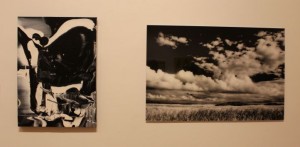 On view now through June 18 in the Art Gallery at FGCU is Stand Before Us, an exhibition that pairs photographs by artists Arturo Correa and Steve Pennisi and photographers Dennis Church and Luke Greer. Curated by local abstract artist Veron Ennis, the object of the show is to encourage
On view now through June 18 in the Art Gallery at FGCU is Stand Before Us, an exhibition that pairs photographs by artists Arturo Correa and Steve Pennisi and photographers Dennis Church and Luke Greer. Curated by local abstract artist Veron Ennis, the object of the show is to encourage 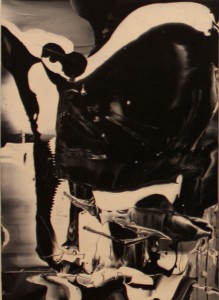 viewers to stand before each pairing and note their similarities (and even differences).
viewers to stand before each pairing and note their similarities (and even differences).
One such pairing is a painting titled Dali Llama by Steve Pennisi and Kahayatle: Miccosukee Native Lands – Everglades, FL. “When comparing [these two works] we find that motion plays a major role in both works of art,” notes Ennis in the comparison she has posted alongside the two artworks. “At the forefront of an approaching storm, the clouds of Kahayatle are windswept and actively travelling across the landscape. The blurred, sweeping white stroke in Dali Llama emulates the cloud’s motion by sweeping up, across and through the highly contrasted black areas at the top of the 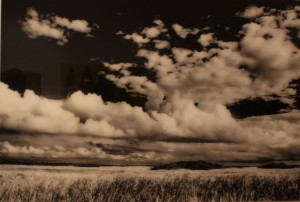 composition. The contrast between the black sky and white clouds in the photograph is as strong and opposing as the black and white strokes in the painting. Both compositions are softened by the midtones found in and around their horizons.”
composition. The contrast between the black sky and white clouds in the photograph is as strong and opposing as the black and white strokes in the painting. Both compositions are softened by the midtones found in and around their horizons.”
Ennis also drew attention to the short areas of vertical pulls in the lower region of the painting 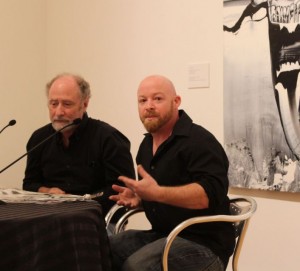 that range from dark to light in a somewhat repetitive pattern. “The dry grasses sprouting from the bottom of Greer’s photograph are also highlighted from the left of the composition and have hundreds of vertical lines repeating horizontally in varying darks and lights.”
that range from dark to light in a somewhat repetitive pattern. “The dry grasses sprouting from the bottom of Greer’s photograph are also highlighted from the left of the composition and have hundreds of vertical lines repeating horizontally in varying darks and lights.”
“Small domes of black float on the spilling strokes in the lower-right quadrant of the Dali Llama,” Ennis continues. “These act as visual anchors in a similar fashion to the islands of the trees found in the 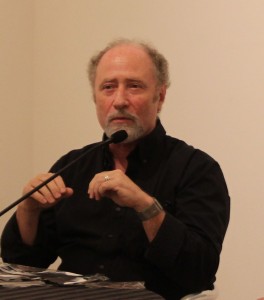 sea of grasses in Kahayatle.”
sea of grasses in Kahayatle.”
Ennis also finds that the high contrast elements in each work of art grab and hold the viewer’s attention. “The flowing, waterfall motions of the paint strokes and the bending blades of grass show movement, and the active, sweeping white whoosh at the top of the painting as well as the travelling clouds in the photograph are energetic and exciting.”
But Ennis only intends these insights as a springboard for further analysis. “As the viewer, you are invited to slow down and stand before these artworks for enough time to genuinely search for connections. Find similarities and 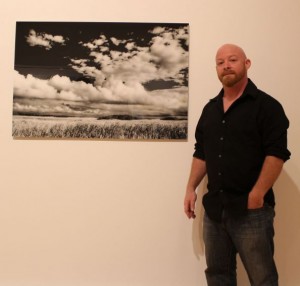 differences, consider how each of the artists found solutions for the composition and form your own opinions about the commonalities that contemporary photography and contemporary painting share today.”
differences, consider how each of the artists found solutions for the composition and form your own opinions about the commonalities that contemporary photography and contemporary painting share today.”
That’s the key. While you do not need an art degree to appreciate fine art photography and abstract paintings, you do need curiosity, an open mind and time. Yes, it takes time to appreciate art, to take note of what the artist did and how the 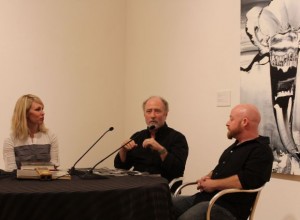 elements that the artist included work synergistically together in the composition. There are no right or wrong answers. It’s all about – and only about – what you see.
elements that the artist included work synergistically together in the composition. There are no right or wrong answers. It’s all about – and only about – what you see.
The exhibition runs through June 18. The gallery is in the Arts Complex on FGCU’s main campus at 10501 FGCU Blvd. S. Parking is available in Lot 7 for gallery visitors. Regular viewing hours are 10 a.m. to 4 p.m. Monday through Friday, and 10 a.m. to 8 p.m. Thursday.
__________________________________________________________________
Photographer Dennis Church gives insight into his process during ‘Stand Before Us’ gallery talk (05-31-15)
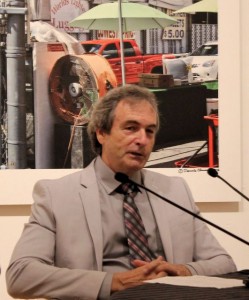 On view now in the Art Gallery at FGCU is Stand Before Us, an exhibition that pairs works by two painters and two photographers. One of those photographers is Dennis Church.
On view now in the Art Gallery at FGCU is Stand Before Us, an exhibition that pairs works by two painters and two photographers. One of those photographers is Dennis Church.
“I have a very strong inner critic which at times can be disabling, so for me, I shoot quickly,” Church told the crowd who attended the exhibition’s opening and round table Gallery Talk. “Everybody has a critic in their psyche that’s troubling … talking, talking, talking … but I decided I’m going to avoid mine even though at times it’s pretty strong. So I shoot very quickly when I’m attracted to something.”
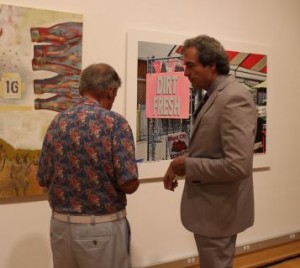 Church also told the group that he gravitates toward scenes that are filled with complexity. “I like pictures that have complexity and depth,” said Church. “I like them because those are the pictures that last. They hang on. They live a lot longer.”
Church also told the group that he gravitates toward scenes that are filled with complexity. “I like pictures that have complexity and depth,” said Church. “I like them because those are the pictures that last. They hang on. They live a lot longer.”
But developing an eye for compositionally complex photos did not come over night. “Eventually, I [took enough shots] it just became second nature, and now I don’t have to think about it anymore. It took a while to get there. It’s sort of like baseball. 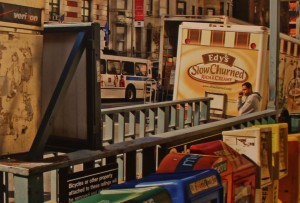 Hitting at first is awkward, but then at some point it becomes automatic and you have reflexes that take over. It’s a training that the mind has to go through, and it’s the same for painters. With a photograph, you have to do it right now, of course. Granted, you may have another chance. If it’s a stationary object, you can shoot many frames, but I found that most of the time it’s the first one
Hitting at first is awkward, but then at some point it becomes automatic and you have reflexes that take over. It’s a training that the mind has to go through, and it’s the same for painters. With a photograph, you have to do it right now, of course. Granted, you may have another chance. If it’s a stationary object, you can shoot many frames, but I found that most of the time it’s the first one 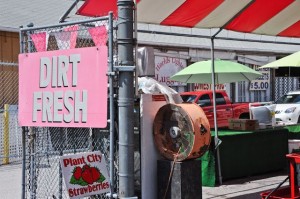 because that’s the intuitive one. If I start thinking about it and trying to perfect it, it doesn’t have the life. It just doesn’t have the same life that the first one does.”
because that’s the intuitive one. If I start thinking about it and trying to perfect it, it doesn’t have the life. It just doesn’t have the same life that the first one does.”
Some psychologists have postulated of late that one has to repeat a task at least 5,000 times to master it. Before digital photography and cell 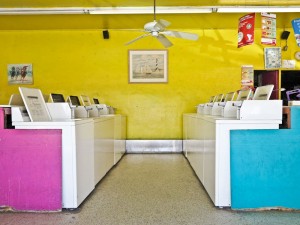 phone cameras, that would have been a very expensive proposition. But now it’s simply a matter of pointing, shooting and uploading, but the key is analyzing each shot with an eye toward improving one’s overall feel for composition. “Composition is what feels right,” Church proclaims. “It’s simply that. We can analyze it after the fact, but it’s what feels right [once you’ve developed that intuitive reflex through repetition].
phone cameras, that would have been a very expensive proposition. But now it’s simply a matter of pointing, shooting and uploading, but the key is analyzing each shot with an eye toward improving one’s overall feel for composition. “Composition is what feels right,” Church proclaims. “It’s simply that. We can analyze it after the fact, but it’s what feels right [once you’ve developed that intuitive reflex through repetition]. 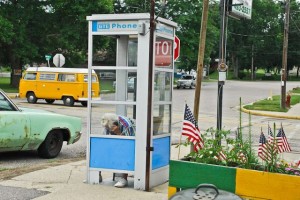 If it works for me, then hopefully it’s going to work for [viewers] as well.”
If it works for me, then hopefully it’s going to work for [viewers] as well.”
Church finds that the complexity he relishes is the best way for him to get viewers into an image and keep them there. “Once they’re in the picture, I want to give them something to do, and that has taken a long time to develop. It’s a conscious effort 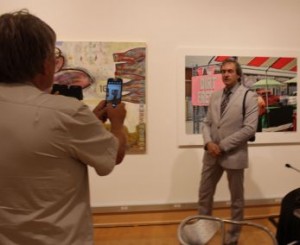 to do that,” says Church, whose images often combine strong geometrical shapes that attract the eye on a subconscious, subliminal level.
to do that,” says Church, whose images often combine strong geometrical shapes that attract the eye on a subconscious, subliminal level.
“A lot of times I’ll pass up a scene because it’s very simple,” Church elaborates. “While there’s nothing wrong with that, it’s just not my purpose. I want to pack the picture with lots of layers and ideas. It really becomes an all-consuming endeavor.”
You can view Church’s images and see how curator 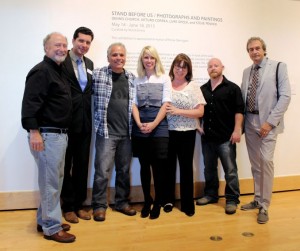 Veron Ennis paired them with paintings rendered by artist Arturo Correa at the Art Gallery at FGCU. The exhibition runs through June 18 and is made possible in part with the generous support of Rona Steingart.
Veron Ennis paired them with paintings rendered by artist Arturo Correa at the Art Gallery at FGCU. The exhibition runs through June 18 and is made possible in part with the generous support of Rona Steingart.
The gallery is in the Arts Complex on FGCU’s main campus at 10501 FGCU Blvd. S. Parking is available in Lot 7 for gallery visitors. Regular viewing hours are 10 a.m. to 4 p.m. Monday through Friday, and 10 a.m. to 8 p.m. Thursday.
______________________________________________________________
Curator Veron Ennis compares Correa painting and Church photo (05-27-15)
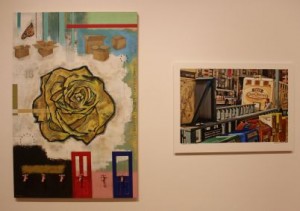 On view now through June 18 in the Art Gallery at FGCU is Stand Before Us, a collection of paired paintings and photographs curated by local modern artist Veron Ennis.
On view now through June 18 in the Art Gallery at FGCU is Stand Before Us, a collection of paired paintings and photographs curated by local modern artist Veron Ennis.
As the name of the exhibition intimates, Ennis challenges viewers to stand before each pairing and search for the elements they share much like you do on Sunday mornings when you scan the 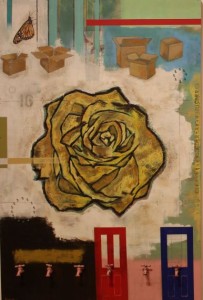 seemingly identical drawings in the newspaper to find the items that are missing from the second drawing.
seemingly identical drawings in the newspaper to find the items that are missing from the second drawing.
Sound daunting? Well, it’s not, and there are, after all, no wrong answers. But to get the ball rolling, Ennis has posted her own comparisons for several of her pairings. For example, among the numerous commonalities that Arturo Correa’s Weaving a Life Under a Yellow Rose and Dennis Church’s New York City, 2008 are elements reflecting daily life and energetic narratives. “The focal point in Correa’s painting is the yellow-toned rose, and in Church’s photograph, the Edy’s ice cream truck, which also has a yellow and peach tonality,” notes Ennis in comparing the pieces. “The central 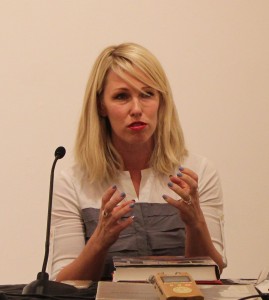 swirling of the rose petals and comparable swirling of the design on the truck’s panel immediately puts the composition into motion,” Ennis continues.
swirling of the rose petals and comparable swirling of the design on the truck’s panel immediately puts the composition into motion,” Ennis continues.
“Along the base of the painting are six pink faucets, which seem to be tempting us to turn them on. Akin to this intent, the newspaper boxes that line the subway entrance entice the viewer to imagine what is in the news that day. The doors in the painting are vertical and contain rectangular shapes. These are very much in harmony with the railings that flank the entrance down to the train,” Ennis observes.
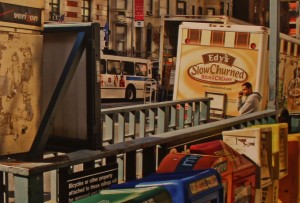 Ennis was also attracted to the open boxes in the upper region of Weaving a Life Under a Yellow Rose. “They are empty, instigating our curiosity, just as the truck behind the Edy’s truck may do, as it is full of unknown boxed items,” Ennis remarks. “The uplifting angles of the cardboard panels, as well as the vertical blue and white bars, lift our view to the top of the composition. In concert with
Ennis was also attracted to the open boxes in the upper region of Weaving a Life Under a Yellow Rose. “They are empty, instigating our curiosity, just as the truck behind the Edy’s truck may do, as it is full of unknown boxed items,” Ennis remarks. “The uplifting angles of the cardboard panels, as well as the vertical blue and white bars, lift our view to the top of the composition. In concert with 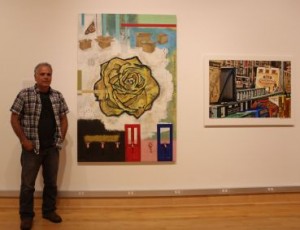 these verticals are the buildings in the background of the photograph with its windows stacked and architectural lines shooting upward. Our eye is kept from shooting off the top of the composition by the strong orange horizontal line across the upper-right of the canvas and in Church’s photograph, the top of the trucks as well as the three orange horizontal bars in the same quadrant.”
these verticals are the buildings in the background of the photograph with its windows stacked and architectural lines shooting upward. Our eye is kept from shooting off the top of the composition by the strong orange horizontal line across the upper-right of the canvas and in Church’s photograph, the top of the trucks as well as the three orange horizontal bars in the same quadrant.”
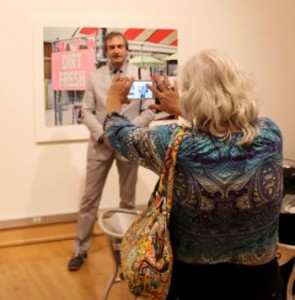 Both works of art, Ennis concludes, have a wide range of color and balance. “Though one composition is vertical and the other is horizontal, each uses similar tactics to form their structure.”
Both works of art, Ennis concludes, have a wide range of color and balance. “Though one composition is vertical and the other is horizontal, each uses similar tactics to form their structure.”
But the idea of the show is for viewers to come up with their own correlations, similarities and even dissimilarities. The exhibition runs through June 18 and is made possible in part with the generous support of Rona Steingart.
The gallery is in the Arts Complex on FGCU’s main campus at 10501 FGCU Blvd. S. Parking is available in Lot 7 for gallery visitors. Regular viewing hours are 10 a.m. to 4 p.m. Monday through Friday, and 10 a.m. to 8 p.m. Thursday.
_______________________________________________________
‘Stand Before Us’ artist Arturo Correa provides windows in which viewers can craft stories of their own (05-20-15)
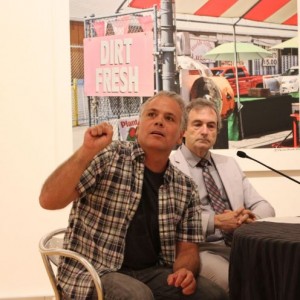 Arturo Correa is one of two painters participating in Stand Before Us, an exhibition pairing paintings and photographs that has been curator by local abstract artist Veron Ennis. In this exhibit, Correa’s paintings are paired alongside photographs by Dennis Church.
Arturo Correa is one of two painters participating in Stand Before Us, an exhibition pairing paintings and photographs that has been curator by local abstract artist Veron Ennis. In this exhibit, Correa’s paintings are paired alongside photographs by Dennis Church.
“I paired them because both have narratives that express a lot about people and their daily lives and issues,” Ennis disclosed at the round table Gallery Talk that accompanied the opening of the show.
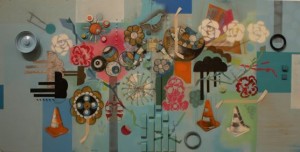 “Before I am an artist, I am a human being, so I paint what I see, what I need, what I connect with, and that to me is the fascinating thing about art – communicating that, communicating what you see and what you connect,” Correa echoes.
“Before I am an artist, I am a human being, so I paint what I see, what I need, what I connect with, and that to me is the fascinating thing about art – communicating that, communicating what you see and what you connect,” Correa echoes.
Correa maintains that painting is about providing 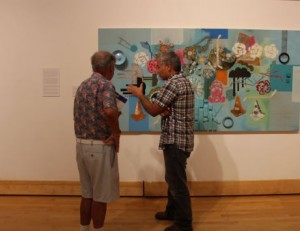 windows to viewers that allow them to craft their own stories or narratives. But there’s a difference between the window s that Correa provides and the windows in your home or office. “You open the window in your house and you see a lot of things going on right in front of you. They’re there for all of us, but each of us have different experiences that cause us to focus on some things and ignore others.”
windows to viewers that allow them to craft their own stories or narratives. But there’s a difference between the window s that Correa provides and the windows in your home or office. “You open the window in your house and you see a lot of things going on right in front of you. They’re there for all of us, but each of us have different experiences that cause us to focus on some things and ignore others.”
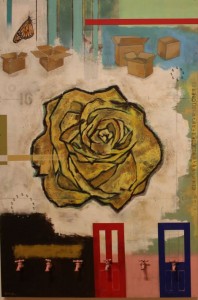 But in constructing his unique painterly windows, Correa forces viewers to take a constellation of seemingly unrelated elements and piece them together into a story or narrative of their own making. “That’s why I give [viewers] faucets, a big yellow flower and a monarch butterfly,” Arturo expounds. “You can take [these elements] and make your own story out of the piece, and that to me is fascinating.”
But in constructing his unique painterly windows, Correa forces viewers to take a constellation of seemingly unrelated elements and piece them together into a story or narrative of their own making. “That’s why I give [viewers] faucets, a big yellow flower and a monarch butterfly,” Arturo expounds. “You can take [these elements] and make your own story out of the piece, and that to me is fascinating.”
Also fascinating is the way his paintings mesh so nicely with the paired photographs of Dennis Church. Both provide disparate objects in their compositions for viewers to weave into stories of their own creation. And both use color, shape and texture in similar ways. So much so, that it even surprised Correa and Church. “When Veron approached me with 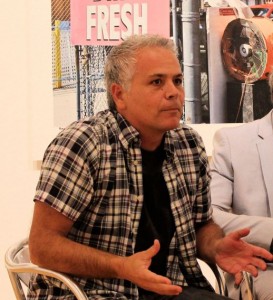 the idea for this exhibit and started showing me Dennis’ images, I couldn’t believe it,” Arturo says with evident wonderment. “Painting and photography are so different, but in the end, they say the same.”
the idea for this exhibit and started showing me Dennis’ images, I couldn’t believe it,” Arturo says with evident wonderment. “Painting and photography are so different, but in the end, they say the same.”
Born in Valencia, Venezuela, Correa holds a Master of Arts in Painting from NYU and a Bachelor of Fine Arts degree from the University of Central Florida at Orlando. He has participated in more than 40 solo and group shows. His works can be found in museums, galleries and other institutions including the 80 Washington Square Gallery and the Rosenberg Gallery 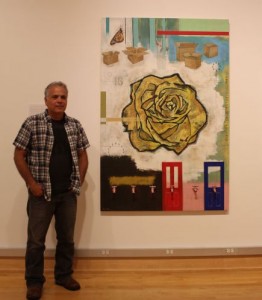 in New York City, the Art Space Virginia Miller Galleries in Miami, the Maracaibo Center of Fine Arts, the Barquisimeto Museum and Juan Carmona Foundation in the State of Lara, Venezuela, the Elvira Neri Art Gallery in Caracas and, in Valencia, at the Braulio Salazar University Gallery. In 2009 he also organized a highly successful exhibition entitled “Paisajes de la Nostalgia” (Landscapes of Nostalgia), supervised by curator Bélgica RodrÃguez, at the Ascaso Art Gallery in Caracas.
in New York City, the Art Space Virginia Miller Galleries in Miami, the Maracaibo Center of Fine Arts, the Barquisimeto Museum and Juan Carmona Foundation in the State of Lara, Venezuela, the Elvira Neri Art Gallery in Caracas and, in Valencia, at the Braulio Salazar University Gallery. In 2009 he also organized a highly successful exhibition entitled “Paisajes de la Nostalgia” (Landscapes of Nostalgia), supervised by curator Bélgica RodrÃguez, at the Ascaso Art Gallery in Caracas.
The exhibition runs through June 18 and is made possible in part with the generous support of Rona Steingart.
The gallery is in the Arts Complex on FGCU’s main campus at 10501 FGCU Blvd. S. Parking is available in Lot 7 for gallery visitors. Regular viewing hours are 10 a.m. to 4 p.m. Monday through Friday, and 10 a.m. to 8 p.m. Thursday.
______________________________________________________________________________________
‘Stand Before Us’ pairings demonstrate that painting and photography on level playing field now (05-19-15)
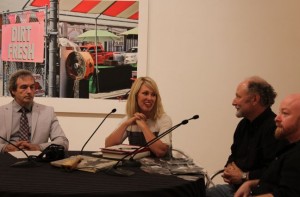 Abstract artist Veron Ennis was inspired to organize an art show pairing two painters and two photographers after hearing an Gallery Talk by art critic Michael Fried. In his book Why Photography Matters as Art as Never Before, Fried states “From the 1970s onward, serious art photography began to be made large scale and for the wall. This immediately compelled
Abstract artist Veron Ennis was inspired to organize an art show pairing two painters and two photographers after hearing an Gallery Talk by art critic Michael Fried. In his book Why Photography Matters as Art as Never Before, Fried states “From the 1970s onward, serious art photography began to be made large scale and for the wall. This immediately compelled 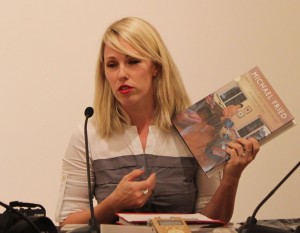 photographers to grapple with issues centered on the relationship between the photograph and the viewer standing before it which, until then, had only been the province of painting.”
photographers to grapple with issues centered on the relationship between the photograph and the viewer standing before it which, until then, had only been the province of painting.”
“I’ve always loved photography, but it really brought to my attention that painting and photography are now on a level playing field where that wasn’t the true just a matter of several 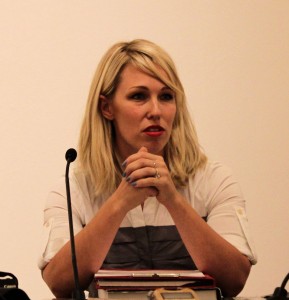 decades ago,” Ennis expands. “But now that photography is accepted as fine art, with it being able to be enlarged and hung on a wall, it is being taken seriously and photographers are being confronted by the same issues that it took painters hundreds and hundreds of years to accomplish.” In fact, with technology, photographers have taken the same strides as their painterly colleagues, but in a greatly compressed timeframe.
decades ago,” Ennis expands. “But now that photography is accepted as fine art, with it being able to be enlarged and hung on a wall, it is being taken seriously and photographers are being confronted by the same issues that it took painters hundreds and hundreds of years to accomplish.” In fact, with technology, photographers have taken the same strides as their painterly colleagues, but in a greatly compressed timeframe.
Fried’s book and Gallery Talk turned out to be life-changing events for Ennis. “Since then, I have 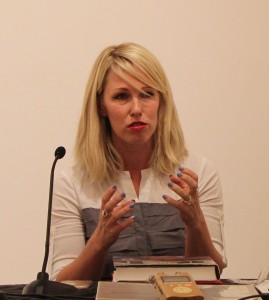 examined photographs as I do my own paintings with a particular eye toward what the photographer had to go through to reach the end result.”
examined photographs as I do my own paintings with a particular eye toward what the photographer had to go through to reach the end result.”
In Stand Before Us, Ennis gives viewers the opportunity to view photography with the same newfound sense of discovery by pairing paintings with photographs in a way that highlights the compositional decisions each artist made during the creative process. “Painters and photographers have different avenues at their disposal to create their artwork, but in the end, they are concerned with composition,” notes Ennis. “How does the final 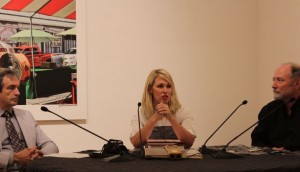 piece look? How is it balanced? How does it communicate with the viewer? So when I was [pairing the pieces included in the exhibit], I was not only looking at obvious colors and things like that, but at how the artist got to his final composition – how they settled on the final arrangement of all the elements in the piece.”
piece look? How is it balanced? How does it communicate with the viewer? So when I was [pairing the pieces included in the exhibit], I was not only looking at obvious colors and things like that, but at how the artist got to his final composition – how they settled on the final arrangement of all the elements in the piece.”
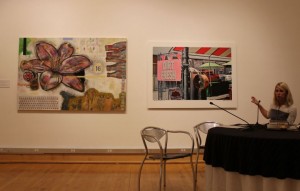 Two of the works that Ennis paired for Stand Before Us are Life as Usual Under a Pink Lily by Arturo Correa and Bonita Springs, Florida 2012 by Dennis Church. “The brightest focal point in each composition is pink; the florescent pink of the ‘Dirt Fresh’ sign in Church’s photograph and the dominating pinks of the large lily in Correa’s
Two of the works that Ennis paired for Stand Before Us are Life as Usual Under a Pink Lily by Arturo Correa and Bonita Springs, Florida 2012 by Dennis Church. “The brightest focal point in each composition is pink; the florescent pink of the ‘Dirt Fresh’ sign in Church’s photograph and the dominating pinks of the large lily in Correa’s 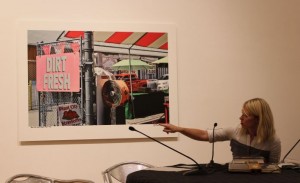 painting,” notes Ennis as a point of entry into the pieces. “Further exploring the composition, we find similar green tones in the umbrella in Bonita Springs and the isolated green in the upper-left corner of Life as Usual. The peach tone in the fan in the photograph is in concordance with the skin tones in the faces in the bottom-right in the
painting,” notes Ennis as a point of entry into the pieces. “Further exploring the composition, we find similar green tones in the umbrella in Bonita Springs and the isolated green in the upper-left corner of Life as Usual. The peach tone in the fan in the photograph is in concordance with the skin tones in the faces in the bottom-right in the 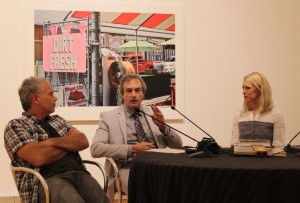 painting. White is found in both compositions to be primarily used in the negative space.”
painting. White is found in both compositions to be primarily used in the negative space.”
Compositionally, Ennis goes on to observe, both works utilize the upper left region as the gateway into the rest of the piece. “The ‘Dirt Fresh’ sign and the pink lily are both strong subjects and attract the eye at first glance and continue to demand 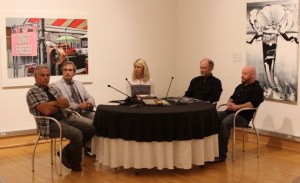 attention even while exploring the other elements. The circular fan is harmony with two elements of the painting: the headphones, which are also circular, floating in the space similar to the fan, and the round faces in the lower region of the painting. The corrugated white pattern that is attached to Life as Usual is in harmony with the
attention even while exploring the other elements. The circular fan is harmony with two elements of the painting: the headphones, which are also circular, floating in the space similar to the fan, and the round faces in the lower region of the painting. The corrugated white pattern that is attached to Life as Usual is in harmony with the 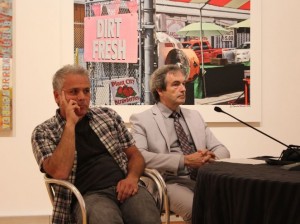 metal fencing found in the same region of Church’s photograph. Interesting, as well, is the use of numbers in the same areas of each composition. There is the number five in the price sign in the photograph and the stenciled number sixteen in Correa’s painting.”
metal fencing found in the same region of Church’s photograph. Interesting, as well, is the use of numbers in the same areas of each composition. There is the number five in the price sign in the photograph and the stenciled number sixteen in Correa’s painting.”
Both compositions, Ennis concludes, are extremely successful at keeping the viewer interested and 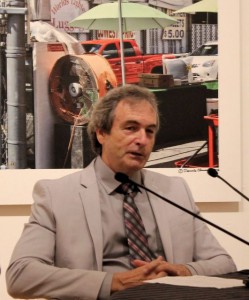 moving the eye around the work of art.
moving the eye around the work of art.
While Ennis has generously provided several summaries explaining the similarities she has found in each pairing, the point is for viewers to stand before each pairing and discover their own compositional commonalities. “Please stand before each pairing and take the time to explore and evolve your own set of similarities,” Ennis extols. If you do, you will discover what Ennis and Fried have discovered, namely that contemporary painting and fine are photography are indeed on an equal footing today and that the playing field between these two disciplines is now level.
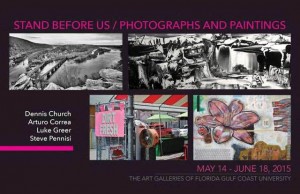 The exhibition runs through June 18 and is made possible in part with the generous support of Rona Steingart.
The exhibition runs through June 18 and is made possible in part with the generous support of Rona Steingart.
The gallery is in the Arts Complex on FGCU’s main campus at 10501 FGCU Blvd. S. Parking is available in Lot 7 for gallery visitors. Regular viewing hours are 10 a.m. to 4 p.m. Monday through Friday, and 10 a.m. to 8 p.m. Thursday.
____________________________________________________________________
Final exhibit of FGCU season, ‘Stand Before Us,’ opens Thursday, May 14 (04-05-07)
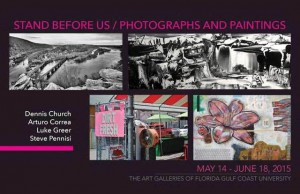 The Art Gallery at FGCU is looking forward to the opening of its final exhibition for the season. Stand Before Us: Photographs and Paintings will open next Thursday, May 14. The evening will begin at 5 p.m. with a Gallery Talk by exhibition curator, Veron Ennis, followed by a reception until 8 p.m. This exhibition brings together four contemporary
The Art Gallery at FGCU is looking forward to the opening of its final exhibition for the season. Stand Before Us: Photographs and Paintings will open next Thursday, May 14. The evening will begin at 5 p.m. with a Gallery Talk by exhibition curator, Veron Ennis, followed by a reception until 8 p.m. This exhibition brings together four contemporary 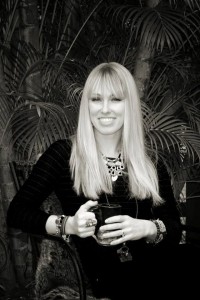 artists, focusing on the compositional similarities in their artworks. The paintings of Arturo Correa and Steve Pennisi will be displayed alongside the photographs of Dennis Church and Luke Greer. Viewers are invited to stand before their large-scale pieces, observing the contrasts and commonalities of each pairing. These juxtapositions explore how composition is used in each medium and how it is the foundation for creating narratives and expressions.
artists, focusing on the compositional similarities in their artworks. The paintings of Arturo Correa and Steve Pennisi will be displayed alongside the photographs of Dennis Church and Luke Greer. Viewers are invited to stand before their large-scale pieces, observing the contrasts and commonalities of each pairing. These juxtapositions explore how composition is used in each medium and how it is the foundation for creating narratives and expressions.
_________________________________________________
Spotlight on ‘Stand Before Us’ artist Steve Pennisi (04-30-15)
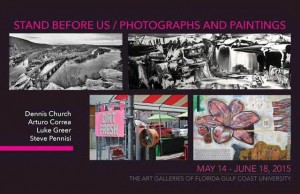 Abstract artist Steve Pennisi developed his unique technique out of a desire to “own something” as an artist. “In my earlier work, what frustrated me was that I knew after a while where the painting would end up and the rest of the process was just a matter of moving to the inevitable conclusion,” Steve reveals. “I wanted to find a way for myself
Abstract artist Steve Pennisi developed his unique technique out of a desire to “own something” as an artist. “In my earlier work, what frustrated me was that I knew after a while where the painting would end up and the rest of the process was just a matter of moving to the inevitable conclusion,” Steve reveals. “I wanted to find a way for myself 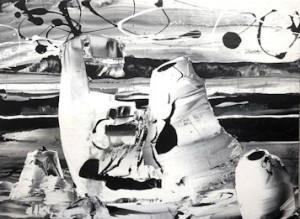 and the viewer to stay open and be continually surprised and engaged.”
and the viewer to stay open and be continually surprised and engaged.”
Then one day, he noticed that a corner of dry paint on his disposable waxed paper palette had peeled up. Underneath, Steve found just what he’d been searching for. When I peeled it off I was amazed at what I found on the hidden side of the paint. It had a life and spontaneity that I had never seen before 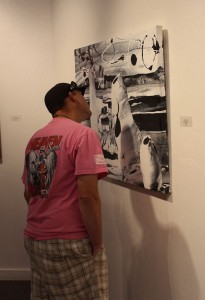 … something that felt human but freed of any doubt or hesitation.”
… something that felt human but freed of any doubt or hesitation.”
Through trial and error, Pennisi discovered that he could paint on clear cellophane, and when he glued it to the canvas the film would peel off, leaving only the paint. His years as a commercial printer made this printing approach second nature, and he further found that when he liked what was happening on the visible surface, he could lay a piece of clear film on the wet paint and capture that image too.
The ability to use “both sides of the paint” offers Pennisi a freedom and expanded palette that enables him to push his artistic possibilities on a daily basis. The paint vacillates between Jackson Pollockesque 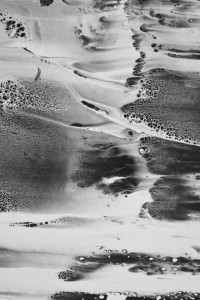 splashes and spatters to pure Ansel Adams-like photographic halftone effects. By stretching the boundaries of artistic conventions such as illusionistic depth, distinct figure and ground, Pennisi is able to bend the paint the way a musician bends a note. The resulting works contain surreal, abstract landscapes and images that are as mesmerizing as there are distinctive.
splashes and spatters to pure Ansel Adams-like photographic halftone effects. By stretching the boundaries of artistic conventions such as illusionistic depth, distinct figure and ground, Pennisi is able to bend the paint the way a musician bends a note. The resulting works contain surreal, abstract landscapes and images that are as mesmerizing as there are distinctive.
“Each composition is original and brave … mysterious, aesthetically,” states Stand Before Us curator Veron Ennis who exhibited with Pennisi in the Florida Contemporary show at the Baker Museum of Art in 2014. This explains why she has paired Pennisi’s paintings with Luke Greer’s photographs. “Steve’s painting technique and brushstrokes with mid-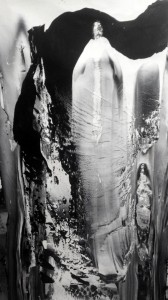 tones providing painterly detail become a landscape with high contrast in the same way Luke Greer juxtaposes his very bright white clouds against very black skies.”
tones providing painterly detail become a landscape with high contrast in the same way Luke Greer juxtaposes his very bright white clouds against very black skies.”
“There’s a dynamic tension between illusionary power and the sheer physicality of the paint,” Pennisi notes. “Before I always knew where a painting would end up; now I must trust, push and cajole to end up with a more poetic approximation.”
For more information about Steve Pennisi and his work, please visit http://www.pennisiart.com/home.html.
Stand Before Us opens with a reception 5 to 8 p.m. on Thursday, May 14 in 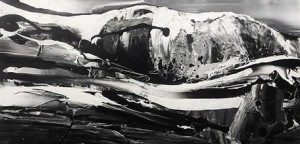 the Main Gallery in the Arts Complex. A round table talk with curator Veron Ennis and the exhibiting artists and photographers will begin at 5 p.m. The exhibition runs through June 18 and is made possible in part with the generous support of Rona Steingart.
the Main Gallery in the Arts Complex. A round table talk with curator Veron Ennis and the exhibiting artists and photographers will begin at 5 p.m. The exhibition runs through June 18 and is made possible in part with the generous support of Rona Steingart.
The gallery is in the Arts Complex on FGCU’s main campus at 10501 FGCU Blvd. S. Parking is available in Lot 7 for gallery visitors. Regular viewing hours are 10 a.m. to 4 p.m. Monday through Friday, and 10 a.m. to 8 p.m. Thursday.
______________________________________________________
Spotlight on ‘Stand Before Us’ photographer Luke Greer (04-27-15)
 The Art Galleries at Florida Gulf Coast University (FGCU) will present “Stand Before Us/Photography and Paintings” in May. This exhibition brings together four contemporary artists: Arturo Correa, Steve Pennisi, Dennis Church and Luke Greer.
The Art Galleries at Florida Gulf Coast University (FGCU) will present “Stand Before Us/Photography and Paintings” in May. This exhibition brings together four contemporary artists: Arturo Correa, Steve Pennisi, Dennis Church and Luke Greer.
Raised in the Civil War borderlands of Loudoun 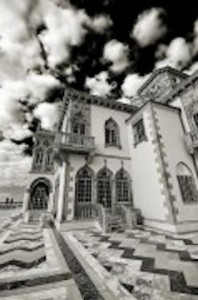 County, Virginia, Luke Greer began his pursuit of photography in order to preserve the landscapes, stories, and collective history of the areas rapidly vanishing rural lifestyle. He currently focuses his black and white photography on the region extending from Gettysburg, Pennsylvania to Richmond, Virginia and throughout the Shenandoah Valley. Rehabilitating orphaned and injured wildlife in his family home since early childhood has instilled a passion for natural world conservation. This is reflected through his Everglades photography. This personal connection with wildlife is the reason he chooses to work with lenses 300mm or less at an average distance of 15 feet. This participatory method requires careful personal interaction with the
County, Virginia, Luke Greer began his pursuit of photography in order to preserve the landscapes, stories, and collective history of the areas rapidly vanishing rural lifestyle. He currently focuses his black and white photography on the region extending from Gettysburg, Pennsylvania to Richmond, Virginia and throughout the Shenandoah Valley. Rehabilitating orphaned and injured wildlife in his family home since early childhood has instilled a passion for natural world conservation. This is reflected through his Everglades photography. This personal connection with wildlife is the reason he chooses to work with lenses 300mm or less at an average distance of 15 feet. This participatory method requires careful personal interaction with the  subject, resulting in the desired direct eye contact for the shot. Whether it be historical locations, endangered landscapes, wildlife, or vanishing local culture, there is a story to be told. Greer captures and accentuates something essential and fascinating in each photograph, that he has the unique ability to recognize based on extensive research and experience.
subject, resulting in the desired direct eye contact for the shot. Whether it be historical locations, endangered landscapes, wildlife, or vanishing local culture, there is a story to be told. Greer captures and accentuates something essential and fascinating in each photograph, that he has the unique ability to recognize based on extensive research and experience.
“I think Greer’s work is incredible, and he is growing as an artist so quickly,” says Stand Before Us curator Veron Ennis (right). “He has a real knack for research and he uses this talent not only to inform his composition and subject, but to find and use the perfect paper, the perfect printing company and the perfect historical process for each image he renders.”
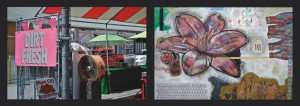 In the latter regard, Greer pays homage through his work to photographic styles in use from the 1860s through the early 1900s. His admiration for historical processes, cameras and other
In the latter regard, Greer pays homage through his work to photographic styles in use from the 1860s through the early 1900s. His admiration for historical processes, cameras and other 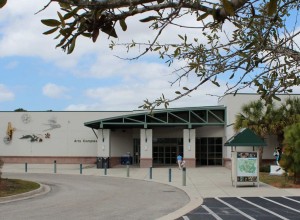 photographic equipment traces, in part, to the antique prints he collects and conserves. He finds his inspiration, too, in photographers who passionately invested themselves in the adventure of their work such as Edward S. Curtis, Alexander Gardner, Julian Dimock & Eddie Adams. Greer’s fine art photographic prints, civil war era colorization canvases, and limited edition black
photographic equipment traces, in part, to the antique prints he collects and conserves. He finds his inspiration, too, in photographers who passionately invested themselves in the adventure of their work such as Edward S. Curtis, Alexander Gardner, Julian Dimock & Eddie Adams. Greer’s fine art photographic prints, civil war era colorization canvases, and limited edition black 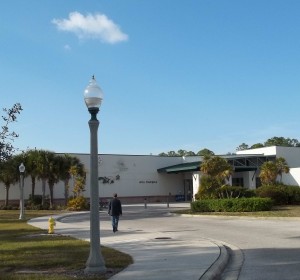 and white images can be found at select galleries and a variety of upcoming events.
and white images can be found at select galleries and a variety of upcoming events.
Stand Before Us opens with a reception 5 to 8 p.m. on Thursday, May 14 in the Main Gallery in the Arts Complex. A round table talk with curator Veron Ennis and the exhibiting artists and photographers will begin at 5 p.m. The exhibition runs through June 18 and is made possible in part with the generous support of Rona Steingart.
The gallery is in the Arts Complex on FGCU’s main campus at 10501 FGCU Blvd. S. Parking is available in Lot 7 for gallery visitors. Regular viewing hours are 10 a.m. to 4 p.m. Monday through Friday, and 10 a.m. to 8 p.m. Thursday.
_________________________________________________________
Spotlight on ‘Stand Before Us’ photographer Dennis Church (04-26-15)
 The Art Galleries at Florida Gulf Coast University (FGCU) will present “Stand Before Us/Photography and Paintings” in May. This exhibition brings together four contemporary artists: Arturo Correa, Steve Pennisi, Luke Greer and Dennis Church.
The Art Galleries at Florida Gulf Coast University (FGCU) will present “Stand Before Us/Photography and Paintings” in May. This exhibition brings together four contemporary artists: Arturo Correa, Steve Pennisi, Luke Greer and Dennis Church.
“I think Dennis Church’s photography is brilliant,” 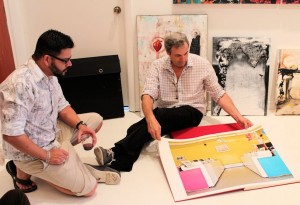 states curator Veron Ennis. “Going through his portfolio for this project blew me away. Dennis says that ‘you have to give the viewer something to do.’ That really stuck with me. It’s important in any form of art.”
states curator Veron Ennis. “Going through his portfolio for this project blew me away. Dennis says that ‘you have to give the viewer something to do.’ That really stuck with me. It’s important in any form of art.”
Church has titled his current series AMERICOLOR. “Each day we move through a 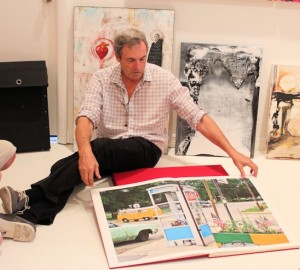 barrage of visual information that results in a cacophony of architecture, advertising, nature, color, and cultural symbols – all creating a landscape that is often chaotic and mind numbing,” Church points out. AMERICOLOR is about bringing order to this visual confusion.
barrage of visual information that results in a cacophony of architecture, advertising, nature, color, and cultural symbols – all creating a landscape that is often chaotic and mind numbing,” Church points out. AMERICOLOR is about bringing order to this visual confusion.
“This extensive series of images, made over eight years, is an experimental approach to photographic seeing, using a disciplined perceptual practice,” Dennis explains. “I tinker 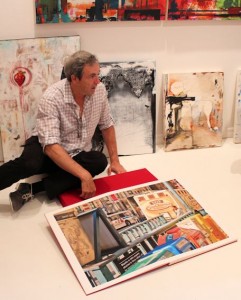 with and often dismantle one-point perspective, creating planar and semi-planar ‘documentary’ style pictures of ordinary and overlooked views in the lineage of Evans–Eggleston. I explore traditional and improvised tools of depiction looking for new solutions to the challenge of presenting the color and form of the complex views I am drawn to. This creates a hyper-realism sometimes seen in paintings based on photographs. Constructing and layering of hues and shapes creates a way for me to comprehend and meditate on the world’s meaning, what I call AMERICOLOR.”
with and often dismantle one-point perspective, creating planar and semi-planar ‘documentary’ style pictures of ordinary and overlooked views in the lineage of Evans–Eggleston. I explore traditional and improvised tools of depiction looking for new solutions to the challenge of presenting the color and form of the complex views I am drawn to. This creates a hyper-realism sometimes seen in paintings based on photographs. Constructing and layering of hues and shapes creates a way for me to comprehend and meditate on the world’s meaning, what I call AMERICOLOR.”
Church possesses the uncanny ability to find shots that not 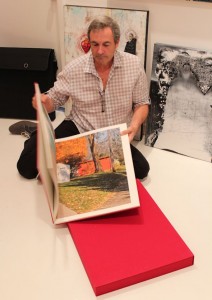 only feature mind-boggling horizontal and vertical planes, but complimentary colors, such as various shades of mint and green opposed by pinks, and hues of yellow contrasting deep blues.
only feature mind-boggling horizontal and vertical planes, but complimentary colors, such as various shades of mint and green opposed by pinks, and hues of yellow contrasting deep blues.
“I don’t own Photoshop.” Instead, Church keeps a sharp eye peeled and his camera at the ready should the right image suddenly appear. “I take a lot of images from my car. With the window still up.”
His process keeps him in the moment, and in the moment there is eternity, joy, energy and excitement that wake him up to all life has to offer.
Born in 1949 in Mason City, Iowa, Church grew up on the family 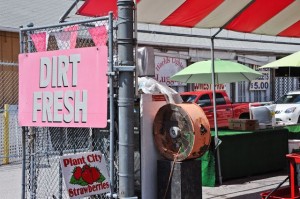 farm in Mitchell County, Iowa. After graduating from Iowa State University in 1975, he moved to Wisconsin to undertake graduate studies in psychology at The University of Wisconsin-Madison. That same year, he began photographing and was so moved by the power of the medium, he left graduate school to pursue artistic goals.
farm in Mitchell County, Iowa. After graduating from Iowa State University in 1975, he moved to Wisconsin to undertake graduate studies in psychology at The University of Wisconsin-Madison. That same year, he began photographing and was so moved by the power of the medium, he left graduate school to pursue artistic goals.
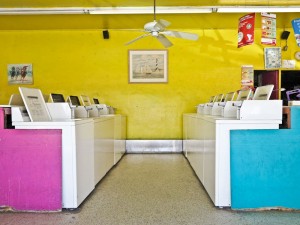 Although he is mostly self-taught, Church has attended artist’s workshops in Millerton, New York and The Visual Studies Workshop in Rochester, New York. He received project art grants in Wisconsin, exhibited extensively in the Midwest, and enjoyed a 20-year career as a freelance photographer, working on assignments for local, regional and national magazines, advertising and public relations firms.
Although he is mostly self-taught, Church has attended artist’s workshops in Millerton, New York and The Visual Studies Workshop in Rochester, New York. He received project art grants in Wisconsin, exhibited extensively in the Midwest, and enjoyed a 20-year career as a freelance photographer, working on assignments for local, regional and national magazines, advertising and public relations firms.
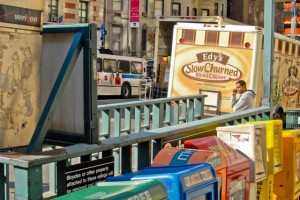 Church left creative photography for close to 20 years to pursue business interests, but began photographing again after being “Rip Van Winkled” awake when he bought some new digital equipment. He has since produced a large body of new work and now lives in Bonita Springs, Florida. He is highly influenced by photographers Garry Winogrand, Lee Friedlander and William
Church left creative photography for close to 20 years to pursue business interests, but began photographing again after being “Rip Van Winkled” awake when he bought some new digital equipment. He has since produced a large body of new work and now lives in Bonita Springs, Florida. He is highly influenced by photographers Garry Winogrand, Lee Friedlander and William  Eggleston, the painter Edward Hopper, and the creative depth and endurance of Bob Dylan.
Eggleston, the painter Edward Hopper, and the creative depth and endurance of Bob Dylan.
Of late, his work is garnering attention both here and abroad. A portfolio of his work has been published by Moscow-based Wonderzine magazine (www.wonderzine.com/wonderzine/life/photo/200157-america), 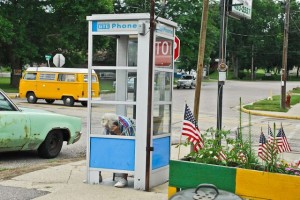 the widely-viewed online magazine/website, LensCulture, picked his work as one of their favorite portfolios for 2013, and in May of 2014, Image in Progress Magazine in Rome (Italy) published a selection of his photographs and three pages of text about his work, artistic background and process. In addition, his work has been featured in solo exhibitions throughout the United States, including the Wisconsin Historical Society and the Darkroom Gallery.
the widely-viewed online magazine/website, LensCulture, picked his work as one of their favorite portfolios for 2013, and in May of 2014, Image in Progress Magazine in Rome (Italy) published a selection of his photographs and three pages of text about his work, artistic background and process. In addition, his work has been featured in solo exhibitions throughout the United States, including the Wisconsin Historical Society and the Darkroom Gallery.
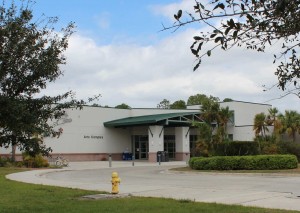 “I photograph to nurture the growth of my vision,” Dennis expounds.” I witness, experience and capture my perception of the light, color and emotional vibration of the spirit of American life.”
“I photograph to nurture the growth of my vision,” Dennis expounds.” I witness, experience and capture my perception of the light, color and emotional vibration of the spirit of American life.”
Stand Before Us opens with a reception 5 to 8 p.m. on Thursday, May 14 in the Main Gallery in the Arts Complex. A round table talk with curator Veron Ennis and the exhibiting artists and photographers will begin at 5 p.m. The exhibition runs through June 18 and is made possible in part with the generous support of Rona Steingart.
The gallery is in the Arts Complex on FGCU’s main campus at 10501 FGCU Blvd. S. Parking is available in Lot 7 for gallery visitors. Regular viewing hours are 10 a.m. to 4 p.m. Monday through Friday, and 10 a.m. to 8 p.m. Thursday.
__________________________________________________________
Curator Veron Ennis discusses parameters, goals of ‘Stand Before Us’ exhibition at Art Gallery at FGCU (04-25-15)
 At the end of each season, the Art Gallery at FGCU hosts a show featuring work by local artists. This year, Director John Loscuito and Assistant Director Anica Sturdivant asked local modern artist Veron Ennis to curate a themed show to end the season. Noting the strides that fine art photography has taken over the past century to
At the end of each season, the Art Gallery at FGCU hosts a show featuring work by local artists. This year, Director John Loscuito and Assistant Director Anica Sturdivant asked local modern artist Veron Ennis to curate a themed show to end the season. Noting the strides that fine art photography has taken over the past century to 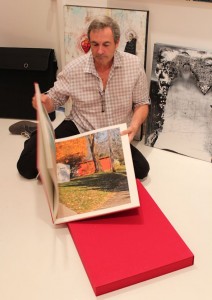 become the equal of contemporary painting, Ennis conceived of an exhibition that compares and contrasts the technology and processes that today’s artists and photographers employ in their quest to create compositions that resonate with viewers.
become the equal of contemporary painting, Ennis conceived of an exhibition that compares and contrasts the technology and processes that today’s artists and photographers employ in their quest to create compositions that resonate with viewers.
Stand Before Us opens in the Art Gallery of FGCU on May 14. The exhibition pairs paintings and photographs by four local artists and fine art photographers. “Arturo Correa and Dennis Church have very colorful compositions that symbolically represent American people and people in general enjoying activities from everyday life,” observes Ennis. “Luke Greer’s landscapes look very similar to Steve Pennisi’s painting technique, which almost becomes a landscape with  high contrast in the same way Greer positions bright white clouds against very black skies.”
high contrast in the same way Greer positions bright white clouds against very black skies.”
To emphasis these contrasts and similarities, Ennis culled through each exhibitor’s portfolio to find comparable pieces. “There are a lot of elements that you can compare with these artists and they will have a lot to say at the round table gallery talk that will take place in conjunction with  the May 14 opening. “
the May 14 opening. “
But to truly appreciate the similarities and contrasts in these tandem pieces, viewers will need to slow down and take their time picking the compositions apart.
“I’m guilty of going through Pinterest at a million miles per hour and looking at maybe 400 pieces of art per minute,” Ennis confesses. “We’re all doing it. We’re viewing at a very fast, a very silly pace and waiting for something to just catch our eye. We might look at something for a minute, but then we move along. So we’re kind of training ourselves to look at things quickly, like a form of speed  reading, except it is images that we’re training ourselves to look at very fast. So I felt it was important to curate an exhibition that encourages viewers to take a real minute and just stand there and form an opinion and identify some themes and ideas.”
reading, except it is images that we’re training ourselves to look at very fast. So I felt it was important to curate an exhibition that encourages viewers to take a real minute and just stand there and form an opinion and identify some themes and ideas.”
Or as Henry David Thoreau once famously stated, “It’s not what you look at that matters, it’s what you see.”
To force viewers to take the time needed to really see the artworks in the exhibition, she had Correa, Church, Pennisi and Greer go large scale.
“The reason the exhibition is called Stand Before Us is because the 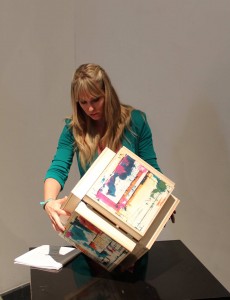 paintings and photographs are immense. I felt that by being more vast, complex and breathtaking, the works would force people to spend a little more time in front of each pairing, a little more time taking note of their similarities and differences.”
paintings and photographs are immense. I felt that by being more vast, complex and breathtaking, the works would force people to spend a little more time in front of each pairing, a little more time taking note of their similarities and differences.”
From collectors to harried tourists rushing through a busy airport terminal, people find that when they look slowly at a piece of art they make discoveries. And one of the most important discoveries they make is that they can see and experience art without being an expert or having an expert on hand to translate the piece for them. That’s an exciting discovery because it unlocks passion and creativity and helps to create more art fans.
 Among the discoveries that Ennis hopes Stand Before Us viewers make is the thought that fine art photographers put into their compositions. “As a painter, I choose where to put things on a canvas.
Among the discoveries that Ennis hopes Stand Before Us viewers make is the thought that fine art photographers put into their compositions. “As a painter, I choose where to put things on a canvas. 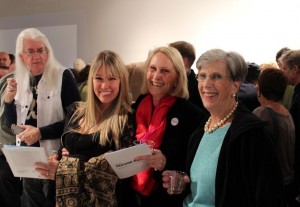 In curating this exhibition, I discovered that fine art photographers like Dennis Church and Luke Greer do too. They’re not just haphazardly snapping pictures in the moment, although that does happen some times. But more often than not, they’re adjusting the frame by moving up, stepping back, or standing on something to create the perfect composition.” In fact, fine art
In curating this exhibition, I discovered that fine art photographers like Dennis Church and Luke Greer do too. They’re not just haphazardly snapping pictures in the moment, although that does happen some times. But more often than not, they’re adjusting the frame by moving up, stepping back, or standing on something to create the perfect composition.” In fact, fine art 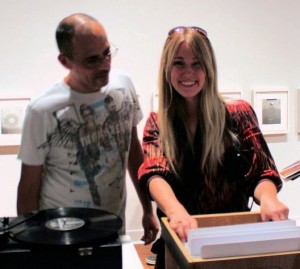 photographers typically make hundreds, perhaps thousands, or micro-decisions in connection with each image in terms of composition, light, color and hue
photographers typically make hundreds, perhaps thousands, or micro-decisions in connection with each image in terms of composition, light, color and hue
“I think it’s really important today, especially with iPhones and tablets as far as photography is concerned to tout that, to recognize that photographers who make this their career make dozens and dozens of decisions to purposely compose their photographs.”
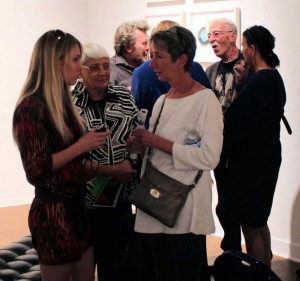 Another point that Ennis wants viewers to take away from Stand Before Us is how quickly photography has gained an equal footing with painting. As an art historian, Ennis knows full well that it has taken painting more than 500 years to progress to its present state. But photography has evolved at an incredible pace. “It’s really become its own incredible form of fine art, and I want to show through this exhibition that painting and fine art photography are equals today.”
Another point that Ennis wants viewers to take away from Stand Before Us is how quickly photography has gained an equal footing with painting. As an art historian, Ennis knows full well that it has taken painting more than 500 years to progress to its present state. But photography has evolved at an incredible pace. “It’s really become its own incredible form of fine art, and I want to show through this exhibition that painting and fine art photography are equals today.”
___________________________________________________
Spotlight on ‘Stand Before Us’ curator Vernon Ennis (04-24-15)
 Veron Ennis is a Fort Myers-based modernist painter concerned with the intimate characteristics of the layered painted medium, the language of color, and the interplay between precision and chance application. Using an underlying grid format, she utilizes an assortment of media to create her paintings, including water-based paints, acrylics, polymer-based grounds, cotton rag paper, raw canvas and wood panel.
Veron Ennis is a Fort Myers-based modernist painter concerned with the intimate characteristics of the layered painted medium, the language of color, and the interplay between precision and chance application. Using an underlying grid format, she utilizes an assortment of media to create her paintings, including water-based paints, acrylics, polymer-based grounds, cotton rag paper, raw canvas and wood panel.
Ennis calls her current body of work Transference. In these new tightly-structured abstracts, Ennis strives to transfer to her viewers elated feelings of love and joy in a non-objective manner. “The transference of information during the creative process from artist to painting to viewer is the reason why art can transcend time and why 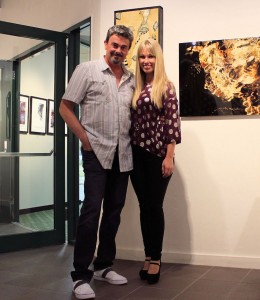 abstract painting has the ability to communicate.
abstract painting has the ability to communicate.
With Stand Before Us, Ennis has curated more than 20 art exhibitions, including the well-attended OPT (open positive transference) art happening staged in Naples’ Mercato Shopping Center in February of 2011 and first-ever art exhibition by the Movement of Aleatoric Modern Artists, held at the Alliance for the Arts in May of 2014. (As a matter of definition, aleatoric art includes any composition that depends upon chance, random accident or highly improvisational execution, typically hoping to attain freedom from academic formula and the limitations 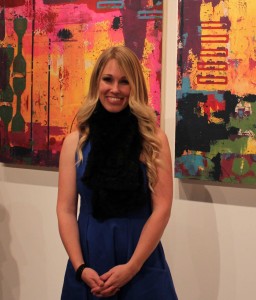 placed on imagination by the conscious mind.) Ennis is a co-founder of both the OPT and aleatoric art movements.
placed on imagination by the conscious mind.) Ennis is a co-founder of both the OPT and aleatoric art movements.
The artist studied graphic design and art history at Virginia Tech. Besides artist and curator, Ennis also functions as an arts journalist and critic. She has written for such publications as ART DISTRICTS magazine, Times of the Islands, RSW Living, Bonita & Estero, Gulf & Main, and Gulfshore Life magazines. Immersing herself into the vast contemporary art world provides an energetic drive, inspiration, and a constant flow of challenges beyond the private, contemplative life of painting in her studio.
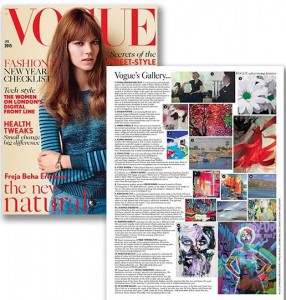 In addition to participating in numerous solo and group exhibitions, Ennis’s work has been featured in the coveted “Vogue’s Gallery” section of British Vogue Magazine and the Florida Contemporary show at the Baker Museum of Art at Artis Naples. Veron is represented by HW Gallery in Naples, RC2 Gallery in Boca Raton, and Von Fraunberg Gallery in Düsseldorf. Veron maintains a studio and viewing space at the Union Artist Studios in the Edwards Building on the campus of the Alliance for the Arts in Fort Myers.
In addition to participating in numerous solo and group exhibitions, Ennis’s work has been featured in the coveted “Vogue’s Gallery” section of British Vogue Magazine and the Florida Contemporary show at the Baker Museum of Art at Artis Naples. Veron is represented by HW Gallery in Naples, RC2 Gallery in Boca Raton, and Von Fraunberg Gallery in Düsseldorf. Veron maintains a studio and viewing space at the Union Artist Studios in the Edwards Building on the campus of the Alliance for the Arts in Fort Myers.
Ennis has been profiled on Art Southwest Florida, and you can access more detailed information about her art and accomplishments by simply clicking here. Please continue reading for more information on Stand Before Us: Photography and Painting.
__________________________________________________________________________
FGCU Art Gallery to host ‘Stand Before Us’ painting and photography show in May (04-20-15)
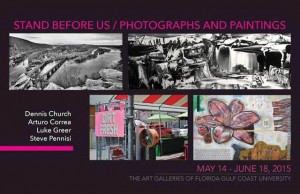 The Art Galleries at Florida Gulf Coast University (FGCU) will present “Stand Before Us/Photography and Paintings” in May. This exhibition brings together four contemporary artists, focusing on the compositional similarities in their artworks. The paintings of Arturo Correa and Steve Pennisi will be displayed alongside the
The Art Galleries at Florida Gulf Coast University (FGCU) will present “Stand Before Us/Photography and Paintings” in May. This exhibition brings together four contemporary artists, focusing on the compositional similarities in their artworks. The paintings of Arturo Correa and Steve Pennisi will be displayed alongside the 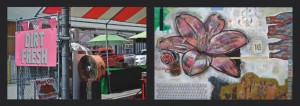 photographs of Dennis Church and Luke Greer. Viewers are invited to stand before their large-scale pieces, observing the contrasts and commonalities of each pairing. These
photographs of Dennis Church and Luke Greer. Viewers are invited to stand before their large-scale pieces, observing the contrasts and commonalities of each pairing. These 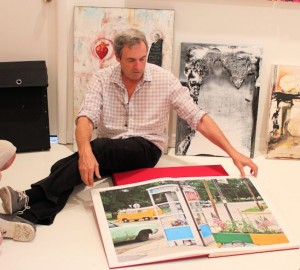 juxtapositions explore how composition is used in each medium and how it is the foundation for creating narratives and expressions.
juxtapositions explore how composition is used in each medium and how it is the foundation for creating narratives and expressions.
The exhibition opens with a reception 5 to 8 p.m. on Thursday, May 14 in the Main Gallery in the Arts Complex. A gallery talk with curator Veron Ennis will begin at 5 p.m. The exhibition runs through June 18 and is made possible in part with the generous support of Rona Steingart.
The gallery is in the Arts Complex on FGCU’s main campus at 10501 FGCU Blvd. S. Parking is available in Lot 7 for gallery visitors. Regular viewing hours are 10 a.m. to 4 p.m. Monday through Friday, and 10 a.m. to 8 p.m. Thursday.














 Tom Hall is both an amateur artist and aspiring novelist who writes art quest thrillers. He is in the final stages of completing his debut novel titled "Art Detective," a story that fictionalizes the discovery of the fabled billion-dollar Impressionist collection of Parisian art dealer Josse Bernheim-Jeune, thought by many to have perished during World War II when the collection's hiding place, Castle de Rastignac in southern France, was destroyed by the Wehrmacht in reprisal for attacks made by members of the Resistance operating in the area. A former tax attorney, Tom holds a bachelor's degree as well as both a juris doctorate and masters of laws in taxation from the University of Florida. Tom lives in Estero, Florida with his fiancee, Connie, and their four cats.
Tom Hall is both an amateur artist and aspiring novelist who writes art quest thrillers. He is in the final stages of completing his debut novel titled "Art Detective," a story that fictionalizes the discovery of the fabled billion-dollar Impressionist collection of Parisian art dealer Josse Bernheim-Jeune, thought by many to have perished during World War II when the collection's hiding place, Castle de Rastignac in southern France, was destroyed by the Wehrmacht in reprisal for attacks made by members of the Resistance operating in the area. A former tax attorney, Tom holds a bachelor's degree as well as both a juris doctorate and masters of laws in taxation from the University of Florida. Tom lives in Estero, Florida with his fiancee, Connie, and their four cats.